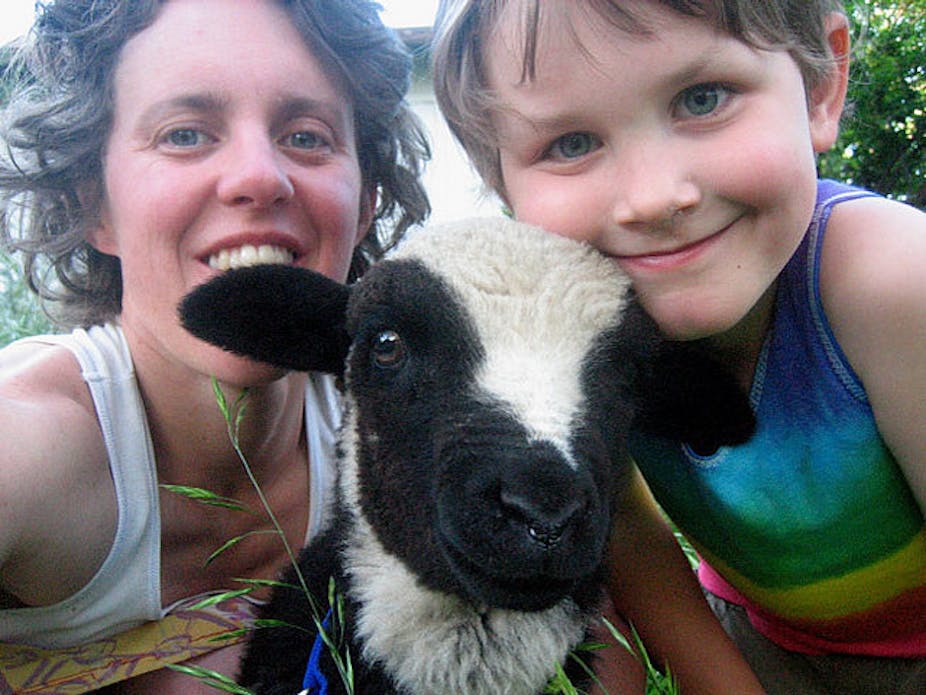As you stand around the BBQ this Australia Day, savouring that quintessential aroma of grilling lamb, spare a thought for the selfless service of our unsung national heroes – our estimated 140 million plus sheep (ovis aries).
And spare a thought for those that made them so tasty. The Australian sheep meat industry has benefited from decades of dedicated scientific research by organisations such as state departments of primary industry and CSIRO. Without that, it’s unlikely your grilled lamb chops would be quite as fresh, juicy, succulent, tender and deliciously flavoursome.
These days the burnt offerings of the past are less acceptable, as people demand grilled meat with a nice pink middle. Even Sam Kekovitch’s latest (over-the-top) effort to boost lamb consumption (see below) – a brave reinvention of the place of lamb in contemporary Australia culture – indicates the messages from celebrity chefs are finally trickling down – we are taking more interest in the subtle flavour of our lamb, basting, marinating and, most importantly, not over-cooking it.
The discovery of fire by our ancestors and its application to meat is probably the oldest form of food processing. During cooking, protein, sugars and unsaturated fats break down and react to form an array of intense flavour and aroma molecules. Our olfactory (smell) receptors and brains are hard-wired to like the molecular signature of grilled meat – even dedicated vegetarians can find meat aroma delicious and almost irresistible.
Behind the scenes, a lot goes into getting the texture and flavour of your lamb chop right. Genetics and breeding are important for meat texture; but probably the most important variable affecting flavour is what the animal has been chowing-down on pre-slaughter.
Scientists are studying changes in gene expression at different life stages. A better understanding of key events in building up muscle meat can help identify how to produce meat that is nutritious, healthy, tender and flavoursome.
These events occur in the embryo, during growth, in response to changes of food and even after slaughter. The laying down of intramuscular fat, which leads to better texture and flavour in the meat, requires a detailed understanding of the interaction of diet and animal metabolism.
The palpable consequences of global warming and the whims of El Niño and La Niña are changes in rainfall patterns and drought. Unlike many other meat-producing countries, in Australia animals generally graze on pastures and are not fed in feed lots, although they may be fed during drought.
Pasture will vary over climate and seasonal cycles, sometimes lacking in nutrients and energy. A severe drought has an impact on the animal’s growth and wellbeing and, not surprisingly, the meat quality.
Insufficient protein or nutrients affect the growth of muscle tissue and the deposition of fat, impacting on meat tenderness and flavour. In a wet year, when pastures are lush, there may be other problems. Some plants may introduce too much of a good thing into the diet, with high protein levels in the pasture resulting in off-flavours such as a “metallic” or “barnyard” in the final meat.

On the grill, it is the rapid reaction of unsaturated fats and amino acids that creates the desirable mouthwatering aroma. Subtle differences in the fat and protein profile due to diet have an impact on the meat’s flavour profile but this is an important area of ongoing investigation. Researchers worldwide have long tried to understand the effects of various pasture diets on positive flavour notes and eating quality of lamb.
Anecdotal evidence from farmers and producers is always vital, but rigorous scientific feeding trials are the mainstay of agricultural progress. In a severe drought year, malnutrition and extensive animal mortality are always a threat to farmers. Access to reliable and cost-efficient “finishing feeds” – such as lucerne (alfalfa), ryegrass and plantain – is essential to get through the extreme years.
Summer and autumn-active forages, such as Brassica plant species, are increasingly being used to supply nutrient-rich forages during periods when pastures are low in nutrient availability. Anecdotally, such forages produce offensive odours during cooking. More scientific evidence is required to support this, to enable the farmer to make informed decisions, without impacting negatively on meat flavour.
Most Australians know we’re on to a good thing with lamb. Slightly fatty, sweet and nutty, lamb aroma can be mouth-watering. If it’s too strong, it can be objectionable – especially to those from other cultures, unfamiliar with unique grass-fed Australian lamb aroma.
When “mutton is dressed up as lamb”, a strong unpleasant odour is often obvious — the offending compounds reside in the fat and trimming the fat usually reduces them. (But not entirely, as the intramuscular fat cannot be removed and some odour will remain.)
Finding the compounds responsible for “mutton flavour” continues to be a key research goal, to which Australian scientists have already made an important contribution. The most likely cause for the flavour seems to be minute quantities of branched chain fatty acids (BCFAs). Normally these increase with animal age, but even low amounts of BCFAs in young animals can be a problem.
The relationship between breeding and feeding is a complex area that requires effective collaboration of multidisciplinary teams: plant breeders, animal breeders, farmers, geneticists, molecular biologists, food scientists, flavour chemists and sensory and consumer scientists.
We’re all working hard at this – and you can help too. How? Just be sure not to burn your chops on the barbie this Australia Day.

